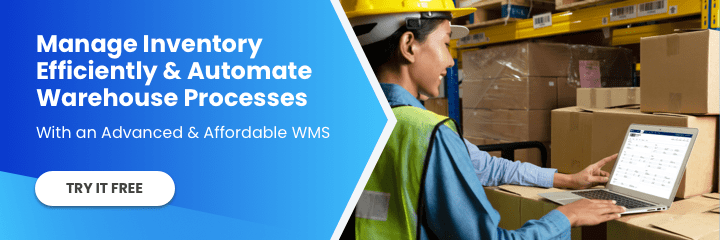Is your warehouse management system (WMS) falling short of expectations? If your team isn’t fully trained on your WMS, it can lead to costly inefficiencies, errors, and frustrated employees. WMS training is the key to unlocking the full potential of your system. This guide explains why WMS training is essential for maximizing warehouse efficiency, reducing errors, boosting your bottom line, and ensuring a smooth implementation process.
We’ll explore how training empowers your workforce to optimize inventory management, streamline order fulfillment, and minimize errors. Additionally, we’ll discuss various training programs and share best practices to ensure that your WMS training initiatives yield the desired results. Read the full blog to learn more.
Why WMS Training is Essential for Success
Warehouse management systems (WMS) have revolutionized warehouses’ operations by automating processes and improving overall efficiency. However, to fully leverage the capabilities of a WMS, proper training is crucial.
WMS training equips employees with the skills and knowledge to navigate and utilize the system effectively. By understanding the functionalities and features of a WMS, employees can optimize inventory management, streamline order fulfillment, and minimize errors. Employees may struggle to adapt to the new system without proper training, leading to inefficiencies and costly mistakes.
Additionally, WMS training ensures a standardized approach to warehouse operations. Organizations can establish consistent processes and procedures by training employees on the same system. This improves productivity and enhances collaboration and communication among team members.
Moreover, WMS training plays a crucial role in maintaining data accuracy. Warehouse operations generate vast amounts of data, and a WMS is designed to capture and analyze this data in real time. However, if employees are not trained to input and interpret data correctly, the system’s integrity can be compromised. Training ensures that employees understand the importance of accurate data entry and analysis, leading to better decision-making and improved overall warehouse performance.
Types of WMS Training Programs
Regarding WMS training, various programs cater to different learning styles and organizational needs. Here are some of the most common types of WMS training programs:
1. On-Site Training: This type involves bringing trainers to the organization’s physical location to conduct training sessions. On-site training provides personalized instruction and hands-on practice using the actual WMS. It allows employees to ask questions and receive immediate feedback, ensuring a comprehensive understanding of the system.
2. Online Training: Online training programs are becoming increasingly popular due to their flexibility and convenience. These programs are usually self-paced, allowing employees to learn at their own speed and convenience. Online training can include video tutorials, interactive modules, and quizzes to test understanding. It is a cost-effective option for organizations with geographically dispersed teams or limited training budgets.
3. Vendor-Specific Training: Many WMS vendors offer their own training programs tailored to their specific systems. These programs are designed to provide in-depth knowledge of the vendor’s WMS functionalities and best practices. Vendor-specific training benefits organizations that have recently implemented a new WMS or are planning to switch to a new system.
4. Comprehensive Training: This training covers all WMS aspects, from basic navigation to advanced functionalities.
5. Tailored Training: This customizes the training program to suit different user roles and responsibilities. Warehouse managers may require more in-depth training on system administration and reporting, while pickers and packers may need focused training on order processing and inventory management.

Best Practices for WMS Training
To ensure the success of your WMS training program, it is essential to follow best practices. Here are some key best practices for WMS training:
1. Assess Training Needs: Start by assessing the specific training needs of your team. Identify areas where employees require training and tailor the program accordingly.
2. Set Clear Training Objectives: Define clear and measurable training objectives. What skills and knowledge should participants gain from the training? Having well-defined goals helps both trainers and trainees.
3. Customize Training Programs: Customize the training program to suit your organization’s unique processes and requirements. Generic WMS training may not cover all the specific features and workflows relevant to your business.
4. Utilize Real-World Scenarios: Incorporate real-world scenarios and examples into the training. This helps trainees understand how to apply their knowledge to actual tasks and challenges they’ll encounter in the warehouse.
5. Hands-On Training: Provide hands-on training opportunities where participants can interact with the WMS software. Practical experience is often the most effective way to learn.
6. Engage Experienced Instructors: Choose instructors with expertise in WMS and warehouse operations. Experienced trainers can provide valuable insights and answer questions effectively.
7. Interactive Training Methods: Use interactive training methods such as workshops, simulations, and role-playing exercises to keep participants engaged and encourage active learning.
8. Regular Assessment and Feedback: Conduct regular assessments, quizzes, or practical exercises to gauge trainees’ understanding. Provide constructive feedback to help them improve.
9. Modular Training: Break the training into modular components, covering different aspects of WMS functionality. This allows participants to focus on specific areas and revisit topics as needed.
10. Documentation and Resources: Provide comprehensive documentation, training materials, and resources that participants can reference after the training. This can include user manuals, cheat sheets, and video tutorials.
11. Support and Troubleshooting: Offer ongoing support and troubleshooting assistance after the training. Trainees should know where to turn when they encounter issues or have questions.
12. Include Integration with Existing Systems: If your WMS integrates with other software or systems, ensure that the training addresses these integrations and how data flows between systems.
13. Regular Updates: WMS software is often updated with new features and improvements. Ensure that your training program is updated accordingly to cover these changes.
14. Continuous Learning Culture: Promote a culture of continuous learning within your organization. Encourage employees to seek additional training and stay updated on the latest advancements in WMS technology.
15. Feedback Loop: Encourage trainees to provide feedback on the training program. Use their input to improve future training sessions.
16. Certification Programs: Consider offering certification programs for WMS users who complete the training successfully. Certification can motivate employees and validate their skills.
17. Track and Measure Training Effectiveness: After training, measure its effectiveness by evaluating how well participants can apply their knowledge to improve warehouse efficiency and accuracy. This can motivate them by providing tangible results.
By following these best practices, you can ensure that your WMS training program is effective and relevant and contributes to the success of your warehouse operations.
Conclusion: The Importance of Continuous WMS Training and Development
As the logistics industry continues to evolve, the role of WMS in warehouse operations will only become more critical. To stay competitive and maximize the benefits of a WMS, continuous training and development are essential.
Continuous training ensures that employees stay updated on the latest features and functionalities of the WMS, enabling them to adapt to changing business needs. It also allows organizations to leverage new technologies and industry best practices to drive operational efficiency and customer satisfaction.
In conclusion, mastering warehouse management systems through effective training is a game-changer for any organization. Investing in comprehensive WMS training will equip your team with the skills and knowledge they need to optimize warehouse operations, meet KPIs, enhance productivity, and deliver exceptional results.
For more information about warehouse management systems or technology trends, follow us on LinkedIn, YouTube, X, or Facebook. If you have other inquiries or suggestions, please contact us here. We’ll be happy to hear from you.
- SEO Powered Content & PR Distribution. Get Amplified Today.
- PlatoData.Network Vertical Generative Ai. Empower Yourself. Access Here.
- PlatoAiStream. Web3 Intelligence. Knowledge Amplified. Access Here.
- PlatoESG. Carbon, CleanTech, Energy, Environment, Solar, Waste Management. Access Here.
- PlatoHealth. Biotech and Clinical Trials Intelligence. Access Here.
- Source: https://articles.cyzerg.com/wms-training-best-practices-for-a-successful-wms-adoption






